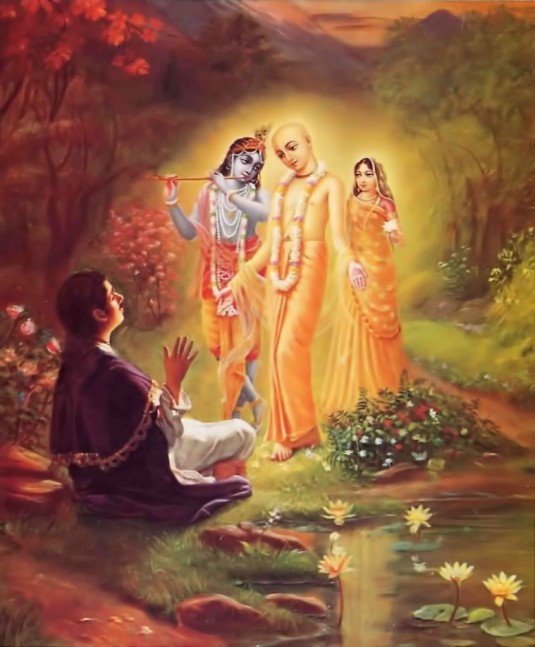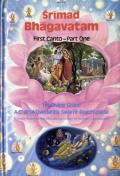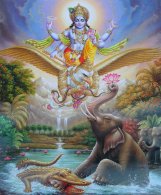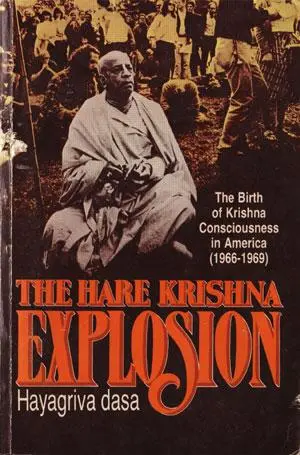click on image to enlarge
Lately, I have been absorbed in reading Sri Caitanya-caritamrta. For me it is a hard book to pick up, but after I begin reading…it is a hard book to put down. Sometimes it seems so esoteric (1 intelligible only to those with special knowledge. 2 intended only for the initiated), but I cannot help but to be thrown into complete and utter awe of the masterful writing, it seems to be Srila Prabhupada’s magnum opus (1 great work of art, literture. 2 the most important work of an artist, writer, etc.). Yes, I have the Oxford Dictionary open on my desk.
The loving affairs of Śrī Rādhā and Kṛṣṇa are transcendental manifestations of the Lord’s internal pleasure-giving potency. Although Rādhā and Kṛṣṇa are one in Their identity, They separated Themselves eternally. Now these two transcendental identities have again united, in the form of Śrī Kṛṣṇa Caitanya. I bow down to Him, who has manifested Himself with the sentiment and complexion of Śrīmatī Rādhārāṇī although He is Kṛṣṇa Himself. (Śrī Caitanya-caritāmṛta, Ādi-līlā 1.5)
The following is a Lecture given on this important verse, and the complete text.
…You cannot understand God, or Kṛṣṇa, without being a faithful servant. This is the secret. And if we become faithful servant under the guidance of proper spiritual master, then we can understand what is Kṛṣṇa, what is Parabrahman, and what is loving affairs with Rādhārāṇī, what is Śrī Kṛṣṇa Caitanya Mahāprabhu. These things are revealed. It is not acquired by so-called mundane knowledge. That is not possible… So we should always remain faithful servant of Kṛṣṇa. And Kṛṣṇa is within everyone’s heart, and He will be pleased by your service, and then He will reveal Himself, what He is. Otherwise it is not possible. (from Śrī Caitanya-caritāmṛta Lecture Ādi-līlā 1.5)
Adi-lila 1.5 Lecture and Verse
Sri Caitanya-caritamrta Lecture
Given by His Divine Grace A. C. Bhaktivedanta Swami Prabhupada
Śrī Caitanya-caritāmṛta, Ādi-līlā 1.5
Māyāpur, March 29, 1975
Nitāi: “The loving affairs of Śrī Rādhā and Kṛṣṇa are transcendental manifestations of the Lord’s internal pleasure-giving potency. Although Rādhā and Kṛṣṇa are one in Their identity, They separated Themselves eternally. Now these two transcendental identities have again united in the form of Śrī Kṛṣṇa Caitanya. I bow down to Him, who has manifested Himself with the sentiment and complexion of Śrīmatī Rādhārāṇī although He is Kṛṣṇa Himself.”
Prabhupāda:
rādhā-kṛṣṇa-praṇaya-vikṛtir hlādinī śaktir asmād
ekātmānāv api bhuvi purā deha-bhedaṁ gatau tau
caitanyākhyaṁ prakaṭam adhunā tad-dvayaṁ caikyam āptaṁ
rādhā-bhāva-dyuti-suvalitaṁ naumi kṛṣṇa-svarūpam
[Cc. Ādi 1.5]
So another feature of Śrī Caitanya Mahāprabhu is described here by the author, Kavirāja Gosvāmī. In the beginning He has been described as the ultimate Absolute Truth, ṣaḍ-aiśvarya-pūrṇaḥ ya bhagavān. The Absolute Truth realized in three phases. The ultimate phase is Bhagavān. Ṣaḍ-aiśvarya-pūrṇaḥ. Bhagavān means full of six opulences. Not as nowadays there are so many Bhagavāns, they have no aiśvarya. But Bhagavān means ṣaḍ-aiśvarya-pūrṇaḥ, full opulences, six kinds of opulence. Then that Bhagavān, Supreme Personality of Godhead, has descended as incarnation, Śrī Caitanya Mahāprabhu, just to bestow the topmost understanding of loving affairs with Kṛṣṇa. Samarpayitum unnata ujjvala-rasāṁ sva-bhakti-śriyam.
In the bhakti platform there are different stages. Spiritually, there is no difference. One in dāsya-rasa and one in mādhurya-rasa, there is no difference. But a devotee likes to serve the Supreme Lord according to his inclination. Some wants to love Him in śānta-rasa, some wants to love Him in dāsya-rasa, someone in friendly, then paternal love, then conjugal love. So there is no difference between these different phases of loving affair, but great devotees and learned scholars, they have given their decision that the loving affairs of Kṛṣṇa in the conjugal platform between husband and wife, or above that, between lover and beloved… That is very much prominent in the Western countries, friend, boyfriend, girlfriend.
In the spiritual world that platform of remaining as friend without marriage, that is considered as the highest. And whatever we see here—a perverted reflection of that loving affairs. Just like perverted reflection… It is described in the Bhagavad-gītā, ūrdhva-mūlam adho-śākha aśvatthaṁ prāhur avyayam. This material world has been described as having its root up, ūrdhva-mūlam adho-śākha, and the branches down. We have several times explained this ūrdhva-mūlam adho-śākha. In the material world this is a shadow. Unless it is shadow, how the mūlam, or the root, can be upwards? We have got experience: a tree on the bank of a river. The tree is reflected adho-śākha, on the root upward, shadow. So this is shadow.
Real thing is in the spiritual world. Therefore it is called adho-śākha. Śākha. In the spiritual world the topmost part is this conjugal love, and here, the same thing, when pervertedly reflected, it is the lowest abominable thing. We should know this, that in the spiritual world, to remain as girlfriend and boyfriend, that is the topmost pleasure, and in the material world, the same thing is the most abominable thing. Therefore it is adho-śākha. We cannot imitate the loving affairs of Kṛṣṇa and Rādhārāṇī unless we understand the real fact.
The real fact is described here, that rādhā-kṛṣṇa-praṇaya-vikṛtir hlādinī śaktiḥ. Śaktiḥ means potency. So from Vedas we understand that the Lord, the Supreme Person, has got multi-energies.
parāsya śaktir vividhaiva śrūyate
svābhāvikī jñāna-bala-kriyā ca
na tasya kāryaṁ karaṇaṁ ca vidyate
na tat-samas abhyadhikaś ca dṛśyate
[Cc. Madhya 13.65, purport]
So these energies… Kṛṣṇa, or the Supreme Personality of Godhead, has got multi-energies. When Arjuna requested Kṛṣṇa, “Will You kindly explain some of the energies as You display?” so in the Bhagavad-gītā there is a list of His different energies. And at last, it is concluded,
atha vā bahunaitena
kiṁ jñātena tavārjuna
viṣṭabhya aham idaṁ kṛtsnam
ekāṁśena sthito jagat
[Bg. 10.42]
Idaṁ kṛtsnaṁ jagat: “All the material manifestation…” Material manifestation means these material universes. They are many. This universe, what we see, one only, the sky, the covering, but there are many millions of universes. Yasya prabhā prabhavato jagad-aṇḍa-koṭi [Bs. 5.40]. Koṭi means millions. Jagad-aṇḍa. Jagad-aṇḍa means universes. So Kṛṣṇa says that “All these universes in the material world is display of My one-fourth energy.” Just imagine what is Kṛṣṇa’s energy. Ekāṁśena sthito jagat. And we are trying to imitate Kṛṣṇa. So many rascals, they declare they are Bhagavān. They do not know what is Bhagavān. Bhagavān… These universes are coming, innumerable universes are coming, from the breathing of Mahā-Viṣṇu.
yasyaika-niśvasita-kālam athāvalambya
jīvanti loma-vilajā jagad-aṇḍa-nāthāḥ
viṣṇur mahān sa iha yasya kalā-viśeṣo
govindam ādi-puruṣaṁ tam ahaṁ bhajāmi
[Bs. 5.48]
They have no idea what is Bhagavān. This is one of the description of Mahā-Viṣṇu, that from His breathing, innumerable universes are coming out. When He is exhaling, the universes are coming out, and when He is inhaling, all, everything, is going within Him. This is Bhagavān. So anyway, this is partial exhibition of the energy of the Lord. And this is one-fourth energy. This material world is manifestation of His one-fourth energy. The three-fourth energies are in the spiritual world. So in that spiritual world Kṛṣṇa exhibits His spiritual energy. That is only spiritual energy. This material world is made of material energy, and we are marginal energy.
So when Kṛṣṇa wants to enjoy—the enjoy means these loving affairs between man and woman—that is a fact. That is not an artificial thing. Śrīla Viśvanātha Cakravartī Ṭhākura has explained Vedānta-sūtra, janmādy asya yataḥ [SB 1.1.1]. He has said, ādi rasasya janma yatra. Ādi-rasa. There are twelve kinds of rasas, mellow. Of all of them, the ādi-rasa… Ādi-rasa means the loving affair between man and woman. This is called ādi-rasa. So, Viśvanātha Cakravartī Ṭhākura explains, janmādy asya means the ādi-rasa, loving affairs between man and woman, that is from the Supreme Person. That’s a fact. Unless the loving propensity is there in the Supreme, how it can be reflected? Because this is perverted reflection only, so there must be the origin. So the Māyāvādī philosophers, they cannot understand this. Because they have got bitter experience of this material world, they try to make zero or without any varieties the ultimate goal. Śūnyavādi. Nirviśeṣa-śūnyavādi. The nirviśeṣavāda, impersonalism and voidism, they are of the same nature. The Buddhist philosopher, they say, “Ultimately, everything is zero.” And the Māyāvādī philosopher says not zero, but impersonal. But actually that is not fact. There is everything, variety and personal. But because the philosophers with poor fund of knowledge, they cannot understand, they make it zero or varietyless, nirviśeṣavāda. That, to clean, that to clear the idea, our Kavirāja Gosvāmī says that this Rādhā-Kṛṣṇa prema, loving affairs between Rādhā Kṛṣṇa, it is a fact. It is not imagination. It is a fact. But this fact is different from the fact we have got experience in this world. That is to be understood. Don’t take… Just like sahajiyās. They take the Rādhā-Kṛṣṇa prema just like ordinary lusty affairs in this material world. But that is not the fact. In the Śrīmad-Bhāgavatam there is a verse that the loving affairs of gopīs and Kṛṣṇa, Viṣṇu, it is not ordinary thing. If one can hear from the proper source, and if he understands the real fact of rasa-līlā, then the result will be that his heart, which is full with lusty desire, that will vanish. There will be no more lusty desires. Praṇaya-vikṛtiḥ, this praṇaya-vikṛtiḥ hlādinī. So if anyone understands this praṇaya-vikṛtiḥ, the loving affairs, transformation of different feelings, if one can understand, then his material lusty desires will vanish. This is the result. Hṛd-roga-kāmān apasya apahinoti dhīraḥ. He becomes dhīra.
Here in this material world everyone is adhīra, agitated, agitated by lusty desires. But in the spiritual world they are dhīra. They are not agitated by lusty desires. This is spiritual world. So long we are agitated by the lusty desires, we must know that we are in the material world. That is the test. Just like Yamunācārya says,
yad-avadhi mama cetaḥ kṛṣṇa-padāravindayor
nava-nava-(rasa)-dhāmany (udyataṁ) rantum āsīt
tad-avadhi bata nārī-saṅgame smaryamāne
bhavati mukha-vikāraḥ suṣṭhu niṣṭhīvanaṁ ca
“So long I have been engaged in the service of Kṛṣṇa and I am rendering more and more service and getting spiritual pleasure, since then, as soon as I think of sex life, I immediately spite upon it and I hate to think of it.” This is the result. So people should know what is Rādhā-Kṛṣṇa pra… If one becomes attached to rādhā-kṛṣṇa-praṇaya-vikṛtiḥ, then the test is that his lusty desires will vanish. This is the test. Therefore Kavirāja Gosvāmī explains that “This is not ordinary thing. This is the transformation of the ahlādinī śakti.” Samvit, sandhinī, ahlādinī. The Supreme Lord has got three potencies, or energies, primarily. So this rādhā-kṛṣṇa-praṇaya-vikṛtiḥ is transformation of the pleasure potency. Kṛṣṇa is described in the Bhagavad-gītā, paraṁ brahma. Paraṁ brahma. Paraṁ brahma paraṁ dhāma pavitraṁ paramaṁ bhavān [Bg. 10.12]. That is the explanation given by Arjuna. This is called paramparā system. If we follow Arjuna, Arjuna’s decision should be taken. Arjuna decision is: “Kṛṣṇa is paraṁ brahma.” So the Māyāvādī philosophers, they are after brahma-sukha. Brahma-sukhānubhūtyā. Brahma-sukhānubhūtyā. The source of brahma-sukha is Kṛṣṇa, but they cannot reach up to that point.
itthaṁ (satāṁ) brahma-sukhānubhūtyā
dāsyaṁ gatānāṁ para-daivatena
māyāśritānāṁ nara-dārakeṇa
sākaṁ vijahruḥ kṛta-puṇya-puñjāḥ
[SB 10.12.11]
Śrī Śukadeva Gosvāmī says, “Here is the Paraṁ Brahman.” When he is describing Kṛṣṇa’s pastimes with the cowherd boys, so Śukadeva Gosvāmī says, “These cowherd boys are playing with the Supreme Person who is the source of brahma-sukha.” Itthaṁ brahma-sukhānubhūtyā. And for the devotees… There are two kinds of transcendentalist: one Brahmavādi and other, Vaiṣṇava. A Vaiṣṇava takes this philosophy, that we are servant. Jīvera svarūpa haya nitya kṛṣṇa dāsa [Cc. Madhya 20.108-109]. And the Māyāvādī philosophers, they imperfectly think that they have become one with the Supreme, they have become Nārāyaṇa. That is a misleading philosophy. We should not accept that.
So this Kṛṣṇa, being Paraṁ Brahman, so what will be the platform of His loving affairs? This is to be considered. For brahma-sukha, we are… In this material world we see many saintly persons. They give up everything, sannyāsa. Sannyāsa means giving up everything for the Supreme. So for simply to relish a little bit of brahma-sukha, these saintly persons, great, great saintly persons, they are giving up everything. Tyaktvā sva-dharmam. Sva-dharma means the regulated division of the society: brāhmaṇa, kṣatriya, vaiśya, śūdra. So they give up everything, brahma-sukhānubhūtyā, to understand… Tapo divyaṁ putrakā yena śuddhyed sattva [SB 5.5.1]. For purifying the existence. Because we are after happiness, every one of us. But we are seeking happiness in the perverted reflection. That is not possible. Therefore one has to give up this perverted happiness and come to the real fact. So our point is that “Because Kṛṣṇa is Paraṁ Brahman, so how He can take pleasure in this material world?”
This is the argument. So those who are wrongly thinking, foolishly thinking, that “Kṛṣṇa enjoyed with the gopīs like we enjoy in the company of many girls,” they are great fools. They have no knowledge. They are misled because it appears, perverted reflection, it appears like that. But the reflection is different from the reality. So we should not take in that way. We should follow the footsteps of Caitanya-caritāmṛta kar, that we should understand that this praṇaya-vikṛtiḥ, this transformation of loving affairs between Rādhā and Kṛṣṇa, this is not like this, the ordinary boy and girl. It is ahlādinī śakti. If we take that, then we are misled. How He can take? Because for understand brahma-sukha we are giving up everything—I mean from the Māyāvādī point of view—and again, Kṛṣṇa being Paraṁ Brahman, how He can indulge in material happiness? This is the argument. Brahma-sukha, to understand brahma-sukha, to release brahma-sukha, if one is giving up everything material… There are three kinds of sukha: material sukha, brahma-sukha, and spiritual sukha. Brahma-sukha is on the margin. Sukha means happiness. Therefore, from logical point of view, we should conclude it that “Kṛṣṇa, being Parabrahman, how He can indulge in material happiness?” This is very important point. If for understanding little bit of brahma-sukha we are giving up all material enjoyment, how Kṛṣṇa can enjoy materially? He is Paraṁ Brahman. Therefore those sahajiyās, those who are taking that Kṛṣṇa is enjoying with ordinary girls, they are very, very, much misled. That is not the fact. Therefore it is said, hlādinī śakti. This is different. This is in the spiritual world the topmost mellow, hlādinī śakti.
So eko brahma dvitīya nāsti: “Brahman, Parabrahman, is one.” Kṛṣṇa is one. There is no competition with Kṛṣṇa. Na tasya samaḥ adhikaś ca dṛśyate: “Nobody can be equal with Him; nobody can be greater than Him.” Na tasya samaḥ. Samaḥ means equal, and adhikaḥ means greater. That is Parabrahman. That is Kṛṣṇa. So Kṛṣṇa says also, mattaḥ parataraṁ nānyat: [Bg. 7.7] “There is no more superior entity than Me.” So we have to very carefully study Kṛṣṇa. The Kṛṣṇa consciousness movement means to understand Kṛṣṇa very scientifically. It is not sentiment. One must be very philosophically advanced with scientific knowledge. Jñānaṁ vijñānam. This is vijñāna. It is not sentiment. Jñānaṁ vijñāna-sahitam. Jñānaṁ me paramaṁ guhyaṁ yad vijñāna-samanvitam. Without vijñāna, science, without philosophy to understand Kṛṣṇa, is not possible. You can say that “Do you think that all the devotees, they are all scientist and philosopher?” Yes. The answer is yes. “No, they have no degree of science or philosophy.” And still… Because if you learn science and philosophy, you will have to approach some person who knows the science, knows the philosophy. But the greatest scientist, the greatest philosopher, is Kṛṣṇa. He is within your heart. Īśvaraḥ sarva-bhūtānāṁ hṛd-deśe ‘rjuna tiṣṭhati [Bg. 18.61]. And He says, teṣāṁ satata-yuktānāṁ bhajatāṁ prīti-pūrvakam, buddhi-yogaṁ dadāmy aham [Bg. 10.10]. Anyone who is sincere devotee and always engaged in Kṛṣṇa’s service, Kṛṣṇa says, “I give him education, intelligence. I make him scientist, philosopher.” That is the way. Buddhi-yogaṁ dadāmi. What kind of science? What kind of philosophy? Yena mām upayānti te. “That science, that spiritual science, that spiritual philosophy, I teach him personally.” Why this is so not to all? You may say that if Īśvara, the Supreme Lord, is sitting in everyone’s heart, why He is especially inclined, teṣāṁ satata-yuktānām [Bg. 10.10], one who is engaged twenty-fours hours in His service? Why not others? So that is special mercy for the devotee, special mercy.
Teṣām evānukampārtham aham ajñāna-jaṁ tamaḥ, nāśayāmy ātma-bhāva-sthaḥ [Bg. 10.11]. This is the process. You cannot understand God, or Kṛṣṇa, without being a faithful servant. This is the secret. And if we become faithful servant under the guidance of proper spiritual master, then we can understand what is Kṛṣṇa, what is Parabrahman, and what is loving affairs with Rādhārāṇī, what is Śrī Kṛṣṇa Caitanya Mahāprabhu. These things are revealed. It is not acquired by so-called mundane knowledge. That is not possible. Svayam eva sphuraty adhaḥ. Just like in the darkness, if you want the sunshine, it is not possible. But in the morning the sun comes out automatically and the darkness is dissipated. Svayam eva. So we should always remain faithful servant of Kṛṣṇa. And Kṛṣṇa is within everyone’s heart, and He will be pleased by your service, and then He will reveal Himself, what He is. Otherwise it is not possible.
Thank you very much. (end)
Śrī Caitanya-caritāmṛta: Ādi-līlā
By His Divine Grace A. C. Bhaktivedanta Swami Prabhupāda
Adi-lila Chapter One, Text 5
rādhā kṛṣṇa-praṇaya-vikṛtir hlādinī śaktir asmād
ekātmānāv api bhuvi purā deha-bhedaṁ gatau tau
caitanyākhyaṁ prakaṭam adhunā tad-dvayaṁ caikyam āptaṁ
rādhā-bhāva-dyuti-suvalitaṁ naumi kṛṣṇa-svarūpam
rādhā—Śrīmatī Rādhārāṇī; kṛṣṇa—of Lord Kṛṣṇa; praṇaya—of love; vikṛtiḥ—the transformation; hlādinī śaktiḥ—pleasure potency; asmāt—from this; eka-ātmānau—both the same in identity; api—although; bhuvi—on earth; purā—from beginningless time; deha-bhedam—separate forms; gatau—obtained; tau—those two; caitanya-ākhyam—known as Śrī Caitanya; prakaṭam—manifest; adhunā—now; tat-dvayam—the two of Them; ca—and; aikyam—unity; āptam—obtained; rādhā—of Śrīmatī Rādhārāṇī; bhāva—mood; dyuti—the luster; su-valitam—who is adorned with; naumi—I offer my obeisances; kṛṣṇa-svarūpam—to Him who is identical with Śrī Kṛṣṇa.
TRANSLATION
The loving affairs of Śrī Rādhā and Kṛṣṇa are transcendental manifestations of the Lord’s internal pleasure-giving potency. Although Rādhā and Kṛṣṇa are one in Their identity, They separated Themselves eternally. Now these two transcendental identities have again united, in the form of Śrī Kṛṣṇa Caitanya. I bow down to Him, who has manifested Himself with the sentiment and complexion of Śrīmatī Rādhārāṇī although He is Kṛṣṇa Himself.















Sep 17, 2014 @ 15:48:34
Hare Krishna! PAMHO AGTSP,
I am a devotional news reporter seeking article content for a bhakti yoga website. My name is Chaitanya-Shakti dasi.
I noticed out of a large list of devotee blogs, yours is very update. I do not know where you are located, perhaps you are far from a devotional community, but I just wanted to ask…do you know of any devotional news in your area that would be worthy of an article?
The devotee I work for is still building the website, so it is not online yet. Because of this, I am looking for news that is not “this happened on this day” type news, but rather, “so-and-so prabhu is working on this fantastic project to please Srila Prabhupada.”
If you know of any news like that, or can think of any particularly amazing devotees, I would love to get in touch, get an interview, photos, etc. and create an article about it.
Also, of course, if YOU are working on any project that you’d like to share – please do!
Just leave a comment with your contact on one of my blogs, or at my website: http://www.cskinnaird.weebly.com. Or, I can check back here to see if you reply. =)
Thanks for tolerating this long message!
Jai Prabhupada!
Chaitanya-Shakti dasi